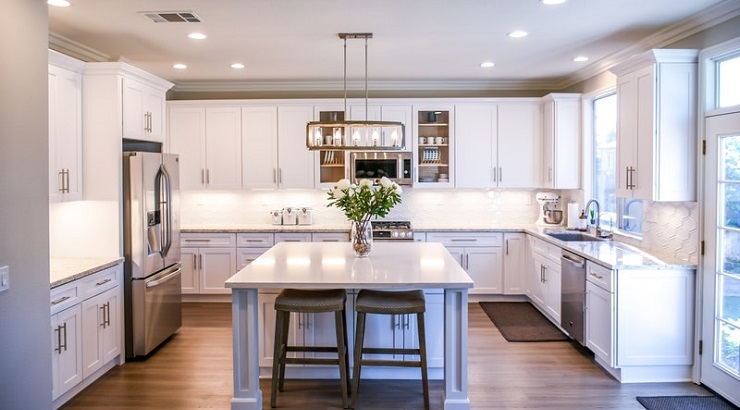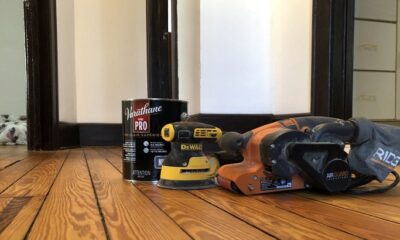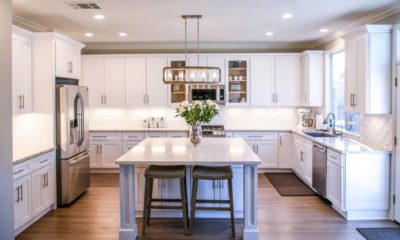DIY Projects
How to Paint Kitchen Cabinets
Easy tips for painting kitchen cabinets like an expert.

Painting kitchen cabinets is a creative way to improve the look and feel of your home without having to incur the huge cost outlays associated with house remodeling projects.
To get started, you need to know the best paint for kitchen cabinets, key tools for the job, what to do before starting work, and the steps to follow when painting kitchen cabinets.
Key requirements
- Paint – The best paint for kitchen cabinets is designed for trim, and is often labeled enamel. You should consider the paint sheen – the glossiness of a paint finish. The higher the sheen of kitchen cabinets paint the more durable the finish.
- Angled paint brush – Usually in the 2½- or 3-inch-wide range, this brush comes with bristles cut at a slant to make it easier to paint clear lines. It helps to get paint into the corners of doors.
- Square paint brush – The straight end of a 3- to 4-inch-wide brush is ideal for painting narrow surfaces such as narrow trim and window grids.
- Roller – Get a 4- or 6-inch foam roller to cover the sides of cabinets and their face frames.
- HVLP Sprayer – If you don’t fancy brushes, a sprayer can be a great alternative for getting a stunning finish. Be sure to get a sprayer that is adaptable enough to spray cabinets.
Before you start
– Set up a makeshift kitchen.
Painting kitchen cabinets is a task that requires you to free up the kitchen, and it is therefore advisable to set up a temporary kitchen in an adjacent room.
Steps for painting kitchen cabinets
1. Prepare the kitchen
– Begin by removing items from the cabinet, clearing off the counters and taking away any free-standing appliances such as fridge, microwave, etc.
– Move all the kitchen furniture to a nearby room.
– Tape a masking paper over the countertops as well as the floor. In addition, tape a plastic sheet over the backsplash, door, window, and fixed appliances to protect the entire house from dust and fumes.
– Cover the walls around the cabinets.
– Set up a workstation for painting drawers, shelves, and doors. This worktop provides access to all sides of a cabinet door to minimize interruptions when drying.
2. Remove the fittings
– Unscrew the hinge screws from the cabinet frame and remove the doors.
– Moving from left to right, top to bottom, mark each of the item with a numbered tape. Label the edges of cabinet shelves and the lower ends of the drawers.
Keep aside the shelf-hanging hardware.
– At your worktop, get rid of the pulls and hinges and keep what will be reused.
– On the doors, shift the number from the tape to the uncovered wood under one hinge.
– Cover it with new tape.
3. Clean the surfaces
– Using a household cleaner, get rid of grime from the face frames, drawer fronts, shelving, and doors. If this does not work get a stronger cleanser such as trisodium phosphate.
– After cleaning the cabinet, rinse the surfaces with water and allow them to dry.
4. Clean the boxes
– Put on your safety equipment.
– Use an abrasive pad dipped in a liquid deglosser to brush all of the surfaces.
– Place a rag beneath to catch drips. Be sure to wipe away the residue of evaporating deglosser with another clean deglosser-dampened cloth.
RELATED: Painting Ideas for Modern Kitchens
– In case you are shifting the hardware, seal the old screw holes with a filler. Once the filler sets, in about five minutes, remove the excess with a sharp paint scraper.
– Once it hardens completely, use a 100-grit paper to sand it smooth.
-Vacuum the cabinets to eliminate dust that can spoilt the finish. Rub the cabinets with a tack cloth to remove any remaining dust.
5. Prime the boxes
– In case of badly stained cabinets, use a stain-blocking primer to remove the stains. However, for typical stains you just need to use an oil-based or 100% acrylic latex primer.
– Beginning at the top of the cabinet, brush on the primer across the grain and then lightly move the brush over the wet finish in the direction of the grain.
Always pass the brush in a single stroke from one end to the other.
– Be sure to follow the basic structure of the cabinet with a brush. For example, if a rail butts into a stile, paint the rail first, slightly overlapping onto the stile, then paint the stile before the overlap becomes dry.
6. Sand, caulk, and fill
– Once the primer becomes dry, sand the flat surfaces with 220-grit paper.
– Use a medium-grit sanding sponge to sand any profiled surfaces.
– Squash a thin bead of latex caulk into any open joints.
– Pull the tip as you go, then smooth the caulk with a damp finger.
– Use vinyl spackle, smoothed flat with a putty knife to fill up any small dents or scratches.
– Once the spackle dries in about an hour, sand again, vacuum, and wipe with a tack cloth.
– Use a spray can of oil-based primer to spot-prime the spackle and any spots created during sanding. Leave it for about 60 minutes, then sand the primer lightly with 280-grit paper.
– Vacuum all of the surfaces, then wipe them with a tack cloth.
7. Paint the boxes
– Get your favourite paint for kitchen cabinets. If you are using the same shade as the existing color, two coats of paint will give you’re the results.
However, painting a dark finish with a light color is a tough task requiring three coats.
– Starting from top to bottom, paint the cabinet exterior across the grain, then tip it off with the grain. For the interior, use a smooth-surface mini roller to get slightly bumpy texture.
– Between the coats, sand the surfaces lightly, and be sure to clean up the fragments.
8. Prep, prime, and paint the fittings
– This procedure is similar to that for cabinets, only that all the job is done on a worktop to minimise the chance of drips, runs, and sags.
– In case you are painting a paneled door, start with the area around the panel, then the main field of the panel before concluding with the stiles and rails around the edges.
– Keep wiping any paint that falls on adjacent dry surfaces to avoid creating lap marks.
– Once painting is done, lift the door by the screw and one hook, and hang both hooks on a sturdy clothes hanger. Hang the door from a curtain rod until it dries.
9. Place back the stuff
– Once the final coat becomes dry, it is now time to replace the shelves.
-Take away the tape over each door’s number.
– Fix the hinges and knob, and hang them in their original opening.
– Replace the drawer pulls and reinstall each drawer.












